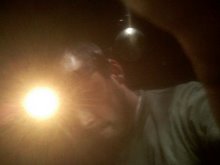
As I surfed the internets the other day, I stumbled across a blog titled Photoshop Disasters. It was dedicated to pointing out the flaws in published images. Each post includes an image and a snarky caption describing the flaw. The vast majority of images come from advertising, although there are entries from periodicals. For example, in movie poster, they point out how obviously Diane Keaton’s face was cut and pasted (or “comped”) into the composition: “Why do these people hate Diane Keaton? The grin hacked into her face looks like the type of smile mortician clowns might prefer. Also, does Diane Keaton have only three fingers on her right hand?”
Other captions were aimed at a specific audience: “Apparently we’re not aware the airbrush tool has a flow setting.” At first I had trouble recognizing the flaws the blogger was talking about, but as I read more entries, finding the flaws became easier. Some of the flaw are hard to notice at first glance because the viewer’s eye is directed toward some other portion of the composition.
Reading this blog made me realize that I did not actively view the content of print advertising. I was not critical of the information being presented to me. Many of the flaws were egregious, but had they not been pointed out, I probably would not have noticed. Before reading this blog I never considered the how much of what is shown in advertising is completely fabricated. An ad featuring a blender also featured some comping that resulted in skewed perspective. As the blogger pointed out, “If you’re wondering if it was the blender, the woman, or the table that was comped in, the answer is probably all three.” As I studied the picture, sure enough it became obvious that the three items the blogger named did not appear to be in the same room together.

